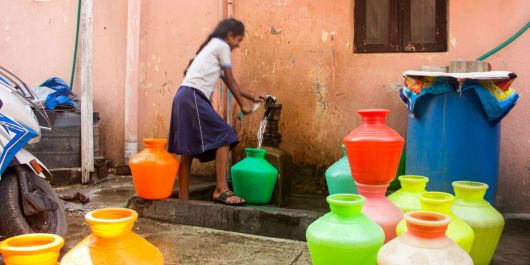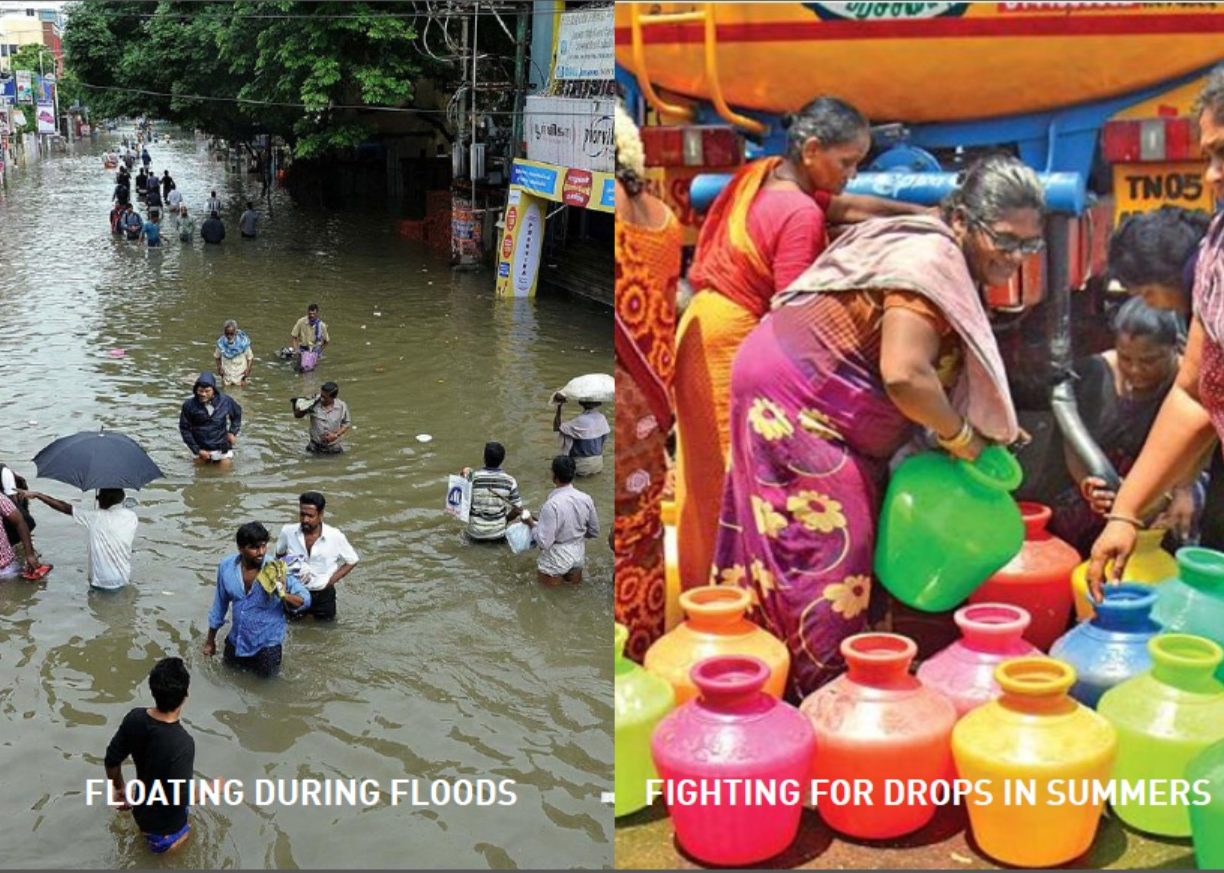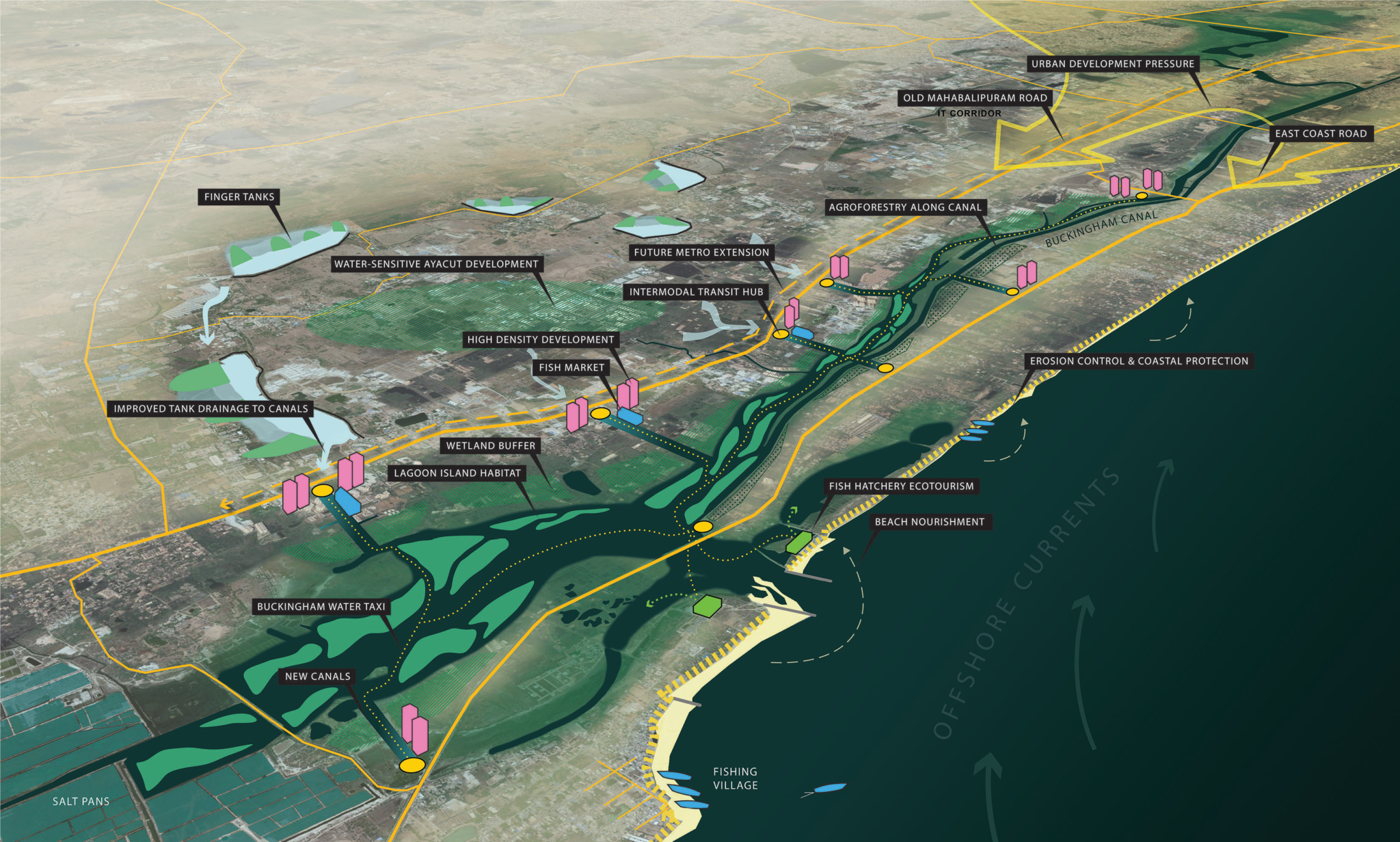12/11/2019 - Making Chennai climate-resilient: The Water as Leverage initiative

This story is written by Dusyant Mohil, PfR country lead India, and was publsihed on the Wetlands International website.
The flooding event in 2015 and drought this year has brought international attention to Chennai, the capital city of Tamil Nadu. Once known as the ‘City of 1,000 tanks’, Chennai now has one of the lowest per capita water availability among the major Indian cities. Last summer, trains of water were brought in as the city’s water structures have run dry. It is very difficult to see a city where water forms an integral part of its culture (temple tanks exhibit the importance of water bodies), to a city where the tapped water supply has become a dream.
The Water as Leverage programme initiated in 2018, aims to tackle urban water-related challenges in an innovative and inclusive way in the city of Chennai. It adopts a comprehensive design-driven approach by bringing all stakeholders to the table with the aim to develop innovative solutions to address problems related to water management and scarcity. The design solutions will help the city be resilient in the face of rising water challenges that will be exacerbated due to climate change.
Water as Leverage started as a competition selecting multi-sectoral proposals to tackle the complex urban water problems in Chennai (India), Khulna (Bangladesh) and Semarang (Indonesia). For the competition, two multidisciplinary teams were selected for each city. Each challenged to develop the best proposals for bankable and implementable projects. These proposals were then connected to funding opportunities and (co-)financiers, such as AIIB (Asian Infrastructure Investment Bank) and FMO (the Netherlands entrepreneurial development bank). The program further partners with the 100 Resilient Cities (100 RC), UN-Habitat, Partners for Resilience (PfR), Architecture Workroom Brussels, Internationale Architectuur Biennale Rotterdam, Water youth network, World Wildlife Fund for Nature, Pegasys, and is supported by the UN/ World Bank High Level Panel for Water, and the Global Center on Adaptation (GCA).
The composition of the design teams often included local partners to ensure community sensitisation and enggaement activities. Partners for Resilience, with Wetlands International South Asia, leading the programme in India has further helped the design teams to understand the community's needs and aspirations and build in their suggestions to reflect local realities. Contributions to the process have ranged from bringing in relevant stakeholders, providing nature-based imperatives for the designs, policies, programmes and legal framework, conducting Vulnerability Capacity Assessment of community members related to water services that have been factored by the two design teams into their final proposals. Potential areas for further assistance include capacity development of communities and government officers on nature-based solutions, climate risk assessments and behavioural change as well as formulating working relationships with local authorities and contributing to knowledge development.
Water Systems in Chennai
Chennai’s topography is flat with gentle slopes, the highest elevation being 6 meters high. Three rivers cut across the city: the Cooum River in the middle, the Adyar River in the south and the Kosasthalaiyar River that flows through the northern industrial fringes of the City. The Buckingham canal with a length of 700 km cuts across these three rivers. Chennai’s rivers have small basins carrying too little fresh water to serve as the water supply for the city. The water in the city moves from the gentle slopes upstream, to the rivers and canals and then to the large wetland areas parallel to the coast. The short span of the rivers with limited water leads to siltation before reaching the coast. It's only during the monsoons when the system is flooded that the rivers connect with the sea.

Growing pains
Chennai houses some of the largest wetland systems in South India and until the 1980s 80% of the city was covered by wetlands. Now that number has reduced to only 15%. Historically, the wetlands were important in providing Chennai with water during drought but are lost to urban expansion. The wetlands in the city are surrounded by areas where economic development is rampant and the pressure to build on them is enormous. Recent development such as the boom in the IT industry and construction of the MGR highway all cut across the wetlands altering the water systems of Chennai. The Pallikarnai marsh, situated in the heart of Chennai has shrunk extensively (90%) owing to ever-expanding real estate, industrial development pressures and dumping of waste. Development initiative like the newly constructed Ennore harbour, has further aggravated wetland loss. The degradation of wetlands was a significant factor for the extensive damage during the floods in 2015 with economic losses amounting to over $ 2.2 billion.
Urban expansion has defined Chennai, leading it to great economic heights. Still, the infrastructure has come at a cost, altering the drainage systems, loss of wetlands and overexploitation of groundwater. As boreholes dig deeper looking for water, geological layers are punctured limiting groundwater recharge. The rivers natural functions are lost, and they currently serve as open sewers with heavy pollution. Flood protection measures such as embankments have further isolated the rivers in the city from its surrounding.
Solutions
The two design teams, City of 1,000 Tanks and Rise Chennai constitute of local and international experts with backgrounds ranging from architecture, sociology, economics, hydrology, engineering, ecology and disaster risk reduction. Over the 9-month process, the two teams worked on developing solutions for Chennai’s water and climate change related problems. The stakeholder process was facilitated through local workshops and the design concepts were signed off by the Water as Leverage Advisory Board during two regional workshops in Singapore. For Chennai, they came up with some very interesting and promising solutions, which are currently being developed further to acquire funding from agencies such as AIIB (Asian Infrastructure Investment Bank), FMO (the Netherlands entrepreneurial development bank, amongst others.
The City of 1,000 Tanks design team intends to develop a closed-loop water system across the City (Chitra Nagar, Mylapore, Koyembedu and Mambalam) by collecting rainwater, treating wastewater and runoff pollution with decentralized Nature-Based Solutions (such as constructed wetlands), and recharging both to the underground aquifer. The system will aim to prevent droughts support groundwater recharge, reduce pollution and mitigate flood risk. With over 50% of the city currently using groundwater to match its need, the groundwater recharge component of the design is quite critical. The design approach is complemented by a governance model where the intent is to create a governance structure to maintain the prototypes.
The Rise Chennai team uses a watershed approach, to build scalable models prototyped on two locations, these proposals address the city's challenges in dealing with water, and use improvements to the water system for wellbeing and offer coastal protection. The prototype for the Mambalam canal will be increasing the floor space index and creating permeable surfaces to allow infiltration. The designs aim to improve the resilience of Chennai’s water network by opening up and redesigning the canal profile, its bridges and surrounding urban developments; mitigating flood risk, improving water quality, groundwater recharge, waste management and reducing water use.
On the Muttukadu coast, the design team aims at reconnecting fishery-based livelihoods with economic opportunities tied to the revitalization of green and blue infrastructures. It adopts water harvesting measures in order to close the water cycle locally. Further to address coastal erosion and future sea-level rise nature-based sand nourishments will protect the coast near the basin’s mouth. The project will also look at developing alternate transport networks such as water taxis on the Buckingham canal.

Muttukadu Coast reimagination by Rise Chennai
Moving ahead
In recent times desalination plants have received greater recognition, whereas the natural water systems, need immediate attention. Though efforts like the Coom river restoration and Pallikarnai Marsh Management plan have been initiated, they lack innovation in terms of integrated approaches. To move ahead, the city master plan may need to place greater emphasis on wetland conservation along with a network of blue and green infrastructure. Wetlands International South Asia sees the Water as Leverage initiative as an opportunity to influence the decision-making and development of water infrastructure projects in Chennai.





